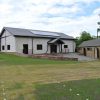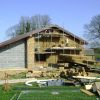
Farmers show they can win the climate change challenge
Climate Week - Britain’s biggest climate change championing event taking place from 4 to 10 March - has announced that the Game & Wildlife Conservation Trust’s (GWCT's) ground-breaking farm building conversion, with a minimal carbon footprint, is a finalist in the 2013 Climate Week Awards. In so doing, Climate Week has recognised that farming has a huge role to play in helping to combat climate change.
This revolutionary building, which was originally a redundant brick built cattle shed, is owned by the GWCT's Allerton Project farm at Loddington in Leicestershire. This leading UK wildlife research charity has already scooped a prestigious award for this sustainable farm building. Nomination for the new Climate Week Award further recognises the environmental credentials of this newly converted visitor centre.
Dr Alastair Leake, Director of Policy with the GWCT said, “In keeping with our own ecological approach to land management, we sought to design a new visitor centre which was constructed using ‘green’ materials whilst still offering state of the art technology. It is a triumph for conservation and the environment.”
The GWCT’s visitor centre, which hosts training courses for policy makers, farmers and conservationists, is constructed using many materials sourced from the farm’s own fields. These include straw bales, sheep fleece insulation and even recycled farm waste materials, normally ending up in landfill, has been cleverly processed and used in the parking area. It is significant that by using recycled and renewable materials the running costs and environmental impact are virtually zero.
Dr Leake says ,”At a time when growing emphasis is being placed on the need for farming to reduce its emissions, we believe that our new visitor centre offers a blueprint that other farmers can follow when converting their own farm buildings. This is not just good news for the climate; it also shows that where governments might fail, farmers can lead the way when it comes to reducing their impact on the environment."
How did we do it? Dr Leake explains, “Climate change is something we all have to face and we all need to re-think the way we operate. As farmers, we have access to a wealth of products that have minimal environmental impact and we can all do more to reduce our greenhouse gas emissions by recycling or by the better utilisation of farmed by-products. For example using sheep fleece insulation means that we have a low carbon insulation material as well as providing another valuable outlet for our sheep’s wool.
“We even have four years of free heat by utilising the thinning’s from our woodland, which are then chipped and used to fuel our biomass boiler.”
The zero running costs and the special design features of this award-winning conversion have already generated interest from a global audience. As a result, the GWCT has published a blueprint for sustainable farm buildings. This free guide contains invaluable information on the products and systems used in the development of the building. For printed or pdf copies, please contact Daniel O’Mahony on 01425 651060 or email: domahony@gwct.org.uk.
Some of the key features of the visitor centre include:
Straw bale insulation – The bricks of the former cattle shed provided support for the roof structure and to provide a high level of insulation, baled wheat straw grown in the farm’s own fields have been used to clad the outside of the building. The bales use eight times less fossil fuel to manufacture than conventional insulation but offer double the insulation capacity.
Sheep’s wool loft insulation – The farm has a flock of 300 sheep and wool is a by-product of lamb production. Thermafleece, made entirely from sheep’s wool provides a low carbon and renewable insulation material and this was installed throughout the building. Each kilo of insulation used locks up the equivalent of 2 Kg of carbon dioxide from the atmosphere and uses seven times less fossil fuel to manufacture than conventional materials.
Rainwater harvesting – Water companies spend millions of pounds each year and fossil fuel energy pumping water around and removing sediments and chemicals to get their supplies to drinking water quality. We then pay to flush most of it away. We collect water from the roof and then store it in underground tanks making it suitable for toilet flushing and washing. The use of harvesting systems can help to buffer the effects of high rainfall, thus reducing flooding.
Biomass boiler – The farm has 30 acres of woodland, which requires thinning. This produced 90-tonnes of seasoned chip in 2012 – sufficient for 4 years of free heat supply to the new building.
Recycled Plastics – The car park uses a membrane made from recycled silage wrap, a material most farmers send to landfill. This also allows the parking area to support insects such as bumblebees and other pollinators through the wild flower seed mixes which are sown between the plastic mesh. The fencing is also made from recycled farm plastic, which removes the need to use paints or preservatives.
Photovoltaic solar panels - were installed on the roof during the construction of the building and these provide all the electrical power to the building with excess supplied to the National Grid.
Wildlife spaces – To ensure better insulation, many modern buildings no longer leave gaps for barn owls and bats to roost. An integral design of the roof space at the visitor centre ensured that bats and barn owls had safe, warm boxes in which they could roost in the roof space.















